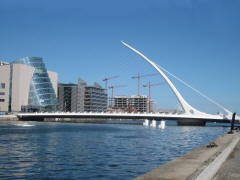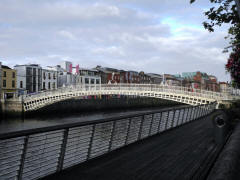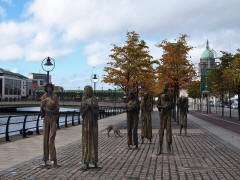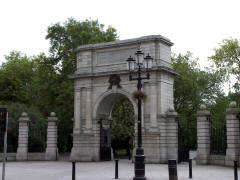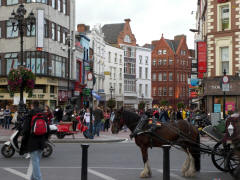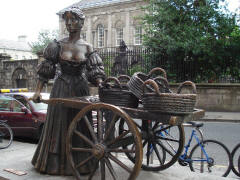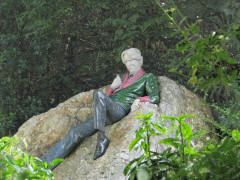|
REPUBLIC OF IRELAND Saturday, 15 September. We got up at 7:30 and had breakfast in the
Horizon Court. The sky was overcast, but we could see
the coast of Wales on the port side. The ship docked in
Dublin about 9:00, and our tour to Glendalough left
about 10:30. The bus first took us on a city tour of
Dublin.
The Republic of Ireland has been independent of Britain only since 1923. Dublin, its capital, was founded by the Vikings as a trading settlement at the mouth of the River Liffey in 841. The modern city of Dublin is divided basically down the middle by the River, which flows into the Irish Sea. Our bus drove a short distance to the Liffey. The guide pointed out the O2 (formerly the Point Theater), Ireland's largest indoor venue, where a wide variety of performances are held, including by Riverdance, the popular Irish step-dancing group. We followed the river upstream (west) past the cantilevered Samuel Beckett Bridge (2009), designed by Calatrava. Just beyond it was the very modern Convention Center (2010). Further upstream we saw the Ha'penny Bridge (1816), an arched pedestrian bridge made of cast iron. There were occasional sailing ships moored in the river along the way.
As we passed Custom House Quay, we saw the
Famine Memorial (1997), a soulful sculpture grouping
dedicated to the Irish people forced to emigrate during
the 19th century Irish Famine. We crossed the river
there and saw the old Customs House (1791) from the
other side. It now houses government offices.
Leaving the river, the bus took us south to St. Stephen's Green (1664), Dublin's largest park (22 acres) and one of its most prestigious areas. Grafton Street, Dublin's main upscale shopping street, begins at one corner of the Green and ends at Trinity College.
Next we visited Trinity
College (1592), Ireland's pre-eminent university. It's
beautiful campus, once outside the city, is now the
heart of one of its busiest sections. The College
library houses many ancient texts, including the Book of Kells, an illuminated manuscript of the four Gospels
dating from circa 800. Just outside one corner of the College is
a
bronze Molly Malone statue (1988), as she wheels her
wheel-barrow, through streets broad and narrow, crying "Cockles and mussels,
alive, alive all!" The statue is
known locally as the Tart
with a Cart, sometimes as the Dish with the Fish, or even
as the Trollop with the
Scallop.
We then drove west through the Temple Bar area of Dublin. Although there is a tavern there called the Temple Bar, that has been the name of this area on the south bank of the River Liffey since the 17th century. After falling into decay, it has since become a quite fashionable cultural quarter, one of the few neighborhoods that has preserved its medieval street pattern and many narrow cobbled streets. Further on, we got a glimpse of Dublin Castle as we rode by. The Castle boasts a tower dating to 1228, but most of the rest dates from the 18th century. Soon after, we passed the Christchurch Cathedral (founded about 1030). older of the two Church of Ireland cathedrals in Dublin. About 11:15 we stopped at St. Patrick's (founded 1191), the other cathedral and the largest church in Ireland. We spent almost an hour exploring St. Patrick's. Jonathan Swift, author of Gulliver's Travels, once headed this cathedral. The bus had to go east again to get to the highway to Glendalough, and we soon found ourselves back at St. Stephan's Green. This time we passed Mansion House (1710), residence of the Lord Mayor. Then we had a brief photo stop on a nearby street lined with Georgian-style buildings, many with colorful doors. On the way we also passed Merrion Square with a very unusual statue of Oscar Wilde (famous Irish writer) reclining on a large rock. The colorful figure is not painted, but made of various color stones. Finally the bus headed southeast toward the coast road to Glendalough in County Wicklow, one of Ireland's most scenic counties. It was a little after 1:00.
Copyright © 2000-2023 DarrellPeck.com All rights
reserved. | ||||||

